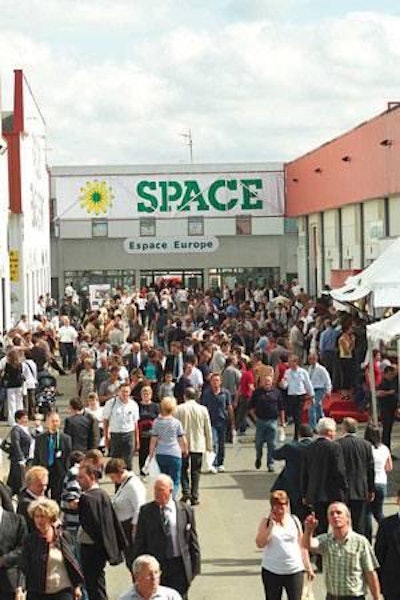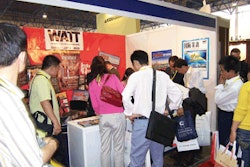
Europe's 2012 deadline to make the changeover from traditional to enriched colony cages for laying hens is fast approaching, but cage-system exhibitors at this year's SPACE International Livestock Show in France insisted they could see no way it was going to be met. The problem is clear, they remarked. With less than three years to go, only a fraction of the European Union's (EU) laying flock is housed in what are seen as welfare friendly cages.
The European Commission may say that egg producers have had enough warning, also that they have been misled by their own organisations into expecting extra time. But the cage companies ask how, in a situation surrounded by so much uncertainty, could the EU egg sector be expected to invest on the massive scale needed so far in advance? A lot can happen in the intervening years as demonstrated by the increased presence of imported eggs and poultry meat in the European market.
Discussion about alternative layer housing systems, such as aviaries and free range, is ongoing. There is strong interest in developments in Germany, The Netherlands and the UK, where free-range production now accounts for about half of the retail shell egg market, but the costs and benefits of such systems are not universally accepted.
Switch from cages comes slowly
Pedro Sanzol, from Spanish manufacturer Zucami, calculates that, as far as his company is concerned, there are only 13 enriched units operating within his area in Europe six in Germany, four in Italy, three in Spain.
Tecno sales manager Renato Zaramella suggested that "a very low percentage" of his customers had switched to enriched cages. A much larger percentage of them were determined to continue using their perfectly sound and relatively new cage operations right up to the deadline.
None of his customers who worked with cages wanted to switch to an alternative system, and virtually everyone was protesting at the time scale of the switch. "For sure, they are not happy to have to do it," he commented, "especially considering the cost and the fact that the government is not giving any grants. The banks are not working properly, either. They ask for such huge guarantees!"
On the Big Dutchman stand, Frank Moormann, sales manager for France, Austria, Greece and Switzerland, said an increasing number of egg producers in France were starting to prepare their units for life with enriched cages. But there was also much discussion about alternative systems such as aviaries and free range. Particular interest was being shown in developments in Germany, Netherlands and the UK, where free-range now accounts for about half of the retail shell egg market.
Says Moormann: "The demand for Big Dutchman enriched cages is growing, following excellent production results from customers in France where the first units went in four years ago and where there are 1.2m layers in enriched BD cages.
"Those with enriched cages say they are delighted with better egg quality, mortality and feed consumption and how it has led to economic success. One client told me that the BD colony system had brought back his delight at being an egg farmer."
France suffering in face of competition
The 21st century is proving to be a difficult time for the poultry meat sector in France. Processing plants have been closing, workers laid off, companies merging and sheds that should be growing chicken and turkey for the French market or export put into mothballs, waiting for better times.
In March, the Gastronome group Terrena bought the poultry operation of Unicopa (158m turnover) to create a goliath valued at 800m. In July, there was a major downsizing at Doux in which at least 640 jobs were lost at processing plants at Locmine (turkeys), Chatelet (chicken) and Pleucadeuc (ducks).
These examples caught the headlines, but the same story is playing out across the industry. Virtually every company or group is thought to have reduced output. Consumption of all meats, red and white, is down 5 percent. Turkey consumption has fallen by 10 percent since 2007 and 38 percent since 2000, laments Gilles le Pottier, chief executive of the national turkey federation CIDEF.
Among those cutting back is Coopagri Bretagne (CB), where chicken and turkeys contribute 9 percent to the company's total turnover of 1.5 billion. Currently, CB's total rearing capacity is put at 340,000m2 from 200 farmers, down from 350 only five years ago. But there were signs of a comeback this summer with the 6.5m takeover of a cooked chicken plant under the Ronsard label in Bresse, the gourmet chicken region close to the German border.
There is also a flourishing 700,000-hen egg operation supplied by 19 cage units and 18 alternative systems. Hen and egg numbers were much higher 30 years ago when CB supplied both its own domestic market and parts of the UK market.
Decade-long decline
Gerard le Boucher, recently retired editor of Filieres Avicole, told a Schering-Plough/Intervet conference at St Malo in September that the poultry meat sector in France had been declining for the past 10 years.
Turkey production had fallen 38 percent since the millennium and, although chicken consumption had risen over the same period, cut-price imports were taking an increasing share of the domestic market. As more and more imported chicken was coming into France, exports were declining. In 2007, the country exported 600mt, down from 800mt in 2003.

















